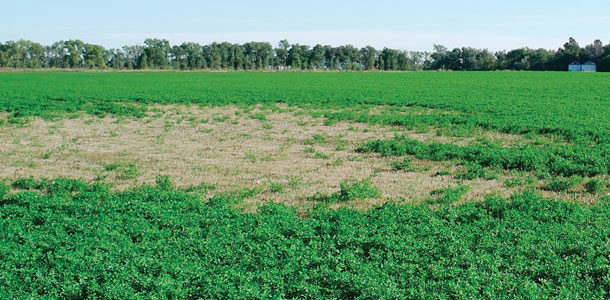The recent historic high hay prices have given alfalfa producers an incentive to maximize the forage production on every alfalfa production acre they have. However, along with the good news of high hay prices, many Western farmers are facing new production challenges that may limit forage production. One such limiting factor is soil salinity and its detrimental effect on alfalfa stand establishment and forage production.
To combat the growing salinity problem, alfalfa breeders have recently released salinity-tolerant varieties bred to enhance stand establishment and forage production in fields known to have variable levels of salinity stress.
These new varieties have the genetic potential to improve production not only on non-saline, top-producing fields but have the added benefit of increased salinity tolerance, allowing them to produce on marginal farm ground that has become less productive due to soil salinity.
This dual benefit of increasing yields on good as well as marginal salinity-affected fields provides the farmer with a tool to help maintain or improve overall forage production and profits on all parts of the farm.
The soil salinity problem
It is estimated that there are 14 million acres of salt-affected soils in the U.S., and according to documentation from the USDA’s Salinity Laboratory, yield reductions due to salinity occur on an estimated 30 percent of all irrigated land in the U.S. It is estimated that about 7.4 acres per day is lost due to soil salinization.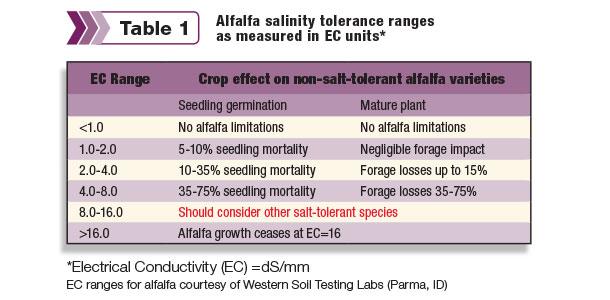
As the salinity problem increases in a field, it adversely affects crop productivity and in some cases makes portions of fields unprofitable or unfarmable. If left unchecked, some soils will become so saline that comprehensive soil and water management solutions are needed to reclaim them.
However, there is a significant amount of farmland in the U.S. classified as marginally saline in which production can be improved with the utilization of salinity-tolerant varieties.
Drought and salinity
One contributing factor to the salinity problem is farmers’ diminishing access to adequate levels of irrigation water for farming. Periodic droughts and higher urban demands for a limited supply of water are contributing to this growing water shortage.
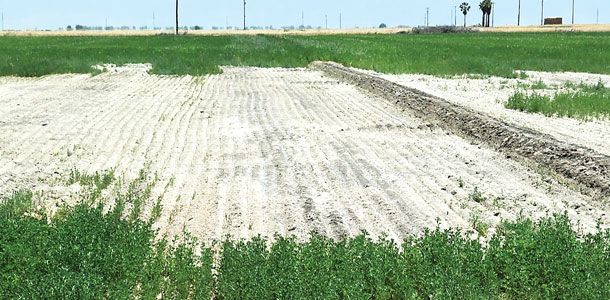
In response to this dwindling water supply, farmers are often forced to reduce the amount of water they use per irrigation. In these cases, the amount of irrigation water applied is generally not enough to leach soil salts from the soil profile, and as a result, salts build up in the soil profile over time.
This irrigation-induced salinity problem increases as farmers move from flood irrigation to sprinkler irrigation as a means of conserving water and improving irrigation efficiency.
Sprinkler irrigation systems apply significantly less water, and as a result, salts carried in the water accumulate near the soil surface compared to flood irrigation, which tends to leach the salts down below the root zone.
Identifying alfalfa forage losses due to salinity
One of the first things a farmer should do if he suspects he has a potential salinity problem is to take a soil sample and have a complete soil analysis done.
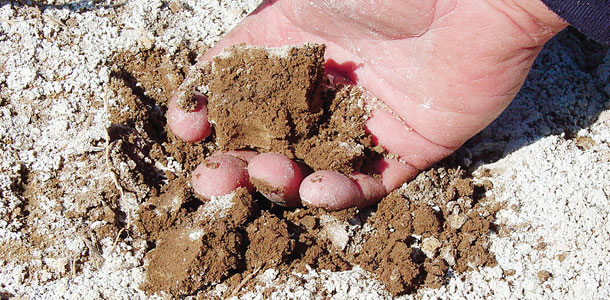
Samples should be taken from good and poor production areas. Multiple quick estimates of the soil salinity can also be obtained using a portable electrical conductivity (EC) meter at a relatively low cost per sample.
Salinity levels are often expressed in EC values that directly correspond to the increase in electrical conductivity of the soil water as related to the total soluble salts content.
In the case of alfalfa, for each point above an EC=2, alfalfa yield is reduced by 7.5 percent. Production fields with EC values of more than 2 have a potential salinity problem and will benefit from the planting of a salt-tolerant alfalfa variety.
Alfalfa production losses due to salinity may occur in several forms in the field. Often the first indications of a salinity problem are poor stand establishment in “saline hot spots” within fields where salinity levels are high enough to kill germinating seedlings or result in plant stunting.
These dead or stunted areas in a field are very obvious and may increase in size over time. If “saline hot spots” are present somewhere on the farm, there is often a significant portion of the adjacent fields that may be marginally saline.
It is not uncommon that significant acres of salinity-related yield losses of 5 to 10 percent may be occurring, often undetected by the farmer. It is in these cases, where variable field salinity occurs, that a top-producing alfalfa variety with the additional trait of salinity tolerance can provide the greatest benefit.
Breeding for alfalfa salinity tolerance
Early breeding efforts focused primarily on developing varieties with increased germination under salinity stress as a means of improving stand establishment.
The first varietal releases displayed significant improvements in germination under salt stress when compared to unselected varieties. Subsequent varietal releases were in the area of improved forage production under salinity stress.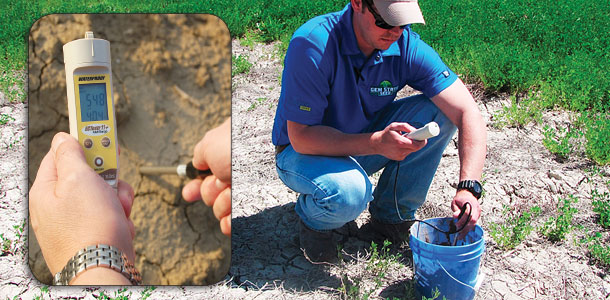
The most recent salinity-tolerant varieties now combine both germination tolerance and improved forage production under salinity stress.
These genetic improvements have proven to be beneficial in marginal saline areas, first by improving stands in “saline hot spots” and later by increasing mature plant tolerance within established stands.
This combined approach has resulted in significant forage yield improvements in fields having yield losses due to variable salinity stress.
It should be noted that the newer salt-tolerant varieties also are top-performing varieties in non-saline soils, but under variable salinity conditions they have the added benefit of the genetic trait for improved salinity tolerance.
These combined traits makes them very well suited to provide maximum yields in variable saline field conditions.
Combating salinity
The ongoing development of new improved salt-tolerant forage crops will continue to give forage producers additional means of minimizing salinity-related production losses and an opportunity to improve profits by fully utilizing all the farm ground available to them.
Although the new advances in salt-tolerant genetics are a big step in combating salinity losses, producers should not consider it as the sole answer. Some saline problems are so severe that improved genetics will not solve the salinity problem alone.
In those cases, utilizing superior genetics combined with sound soil and water management practices can provide an integrated approach to improving forage yield on both saline and marginally saline soils.
Summary
It has been said that any area utilizing irrigation for crop production will eventually have to deal with increased soil salinity. The salinity problem is increasing, and farmers must learn to effectively manage salinity to remain profitable.
One means of accomplishing this goal is by utilizing high-yielding genetically improved alfalfa varieties or other salt-tolerant species bred to perform in marginally saline- affected soils, as well as produce high yields under optimal (non-saline) soil conditions.
The utilization of new salt-tolerant alfalfa varieties combined with sound soil and water management practices can provide an integrated approach to improving yield and ultimately increase forage production and farm revenue. FG
PHOTOS
PHOTO 1: By the time a saline “hot spot” shows up in an alfalfa field, adjacent fields may also contain marginal salinity.
PHOTO 2: An alfalfa field in California capped with white residue displays the severity of saline soil issues.
PHOTO 3: White top-layer crusting is typical in saline soils.
PHOTO 4: A portable EC meter can take salinity readings in a “hot spot” to help a producer determine whether a salt-tolerant alfalfa variety, combined with soil and water management practices, could improve production. Photos courtesy of Don Miller.

Don Miller
Product Development Director
Producer’s Choice Seed
